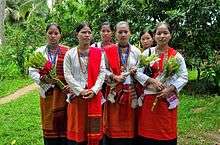Tanchangya people
 | |
| Total population | |
|---|---|
| 51,773[1] | |
| Regions with significant populations | |
|
Majority populations in Bangladesh In Bangladesh the Tanchangya reside in the Chittagong Hill Tracts area and also in India and Mayanmar | |
| Languages | |
| Tanchangya | |
| Religion | |
| Theravada Buddhism |
The Tanchangya people are one of 13 indigenous ethnic communities living in the Chittagong Hill Tracts (CHT) of Bangladesh.
Geographical location
Tanchangya peoples have been living in CHT since its prehistoric age. Nowadays Tanchangya peoples live in Rangamati, Bandarban, Roisyabili & Sadhikyabili (Chittagong district), Ukhia and Teknaf (Cox’s bazaar district) areas of the Bangladesh. Tanchangyas also live in North-east Indian states (Assam, Tripura and Mizoram) and Rakhine State of the Myanmar. Most of Tanchangyas live in reserve forest of CHT but on 10 April 2000 Govt declared a new Forest law named “The forest (Amendment) Act; 2000”; according to this act “Cultivation & preparation of cultivation on reserve forest land are illegal." The survival of these areas peoples becomes difficult for this act.
It is difficult to form a consensus on the exact numbers and spelling of Tanchangyas. According to census of 2001 the number of Tanchangya 31,164 in CHT (source: solidarity2002, Bangladesh Adivasi Forum). According to the report of Daily Prothom-alo the number of Tanchangya is 51,773 in CHT (Published on 3 February 2012).
Dress and ornaments
Traditionally a Tanchangya woman wears colourful dresses and ornaments. The full dresses of Tanchangya women are known as “Paiet kapor”. That means the total dresses consists of five parts. These five parts are:
- (1) “Pinon” which is seven colours with stripes.
- (2) “Fadhuri” which used as belt.
- (3) “Mada-kobong” which wearing upon head.
- (4) “Khadi” as scarf.
- (5) “Shaloom” just like blouse.
Tanchangya women also wear various ornaments. These are “Rajjur & Jhanga” for ears, “Baghor & Kuchikharu” for Wrists and “Tajjur” for arms, “Chandrahar, hachuli & Sikchara” for neck. These ornaments are made by mainly silver. Tanchangya men generally wear loincloth and long sleeve shirts.
Musical instruments
Day by day Tanchangya songs and dance becomes famous. There are many Tanchangya musical instruments such as Bashi, Kengkrong, Chobuk, duduk etc.
Occupation
Agriculture is the main occupation of Tanchangya peoples. Even today they do jhum cultivation and they cultivate paddy, ginger, garlic, bagurpada (e.g.coriander) etc. on hill slopes. Literacy among Tanchangyas is low. A few of them serve in government and non-government organizations. Today, Tanchangya is a developing ethnic community on the international level. Nowadays many Tanchangyas are service people and professionals such as doctors, engineers, lawyers, teachers etc. They also are trying hard to become retail traders.
Games
Tanchangyas celebrate 'Bishu' as a main enjoyable festival on the end and beginning of the Bengali new year. “Pachon” is a special item for Bishu. “Pachon” is a mixed vegetable with dried fishes etc. Now-a-days “Bishu mela” were organized in Tanchangyas localities. “Ghila kala”, “Nahdeng kala” “Gudhu kala” etc. are the Tanchangyas Traditional sports.
Religions
Tanchangya peoples are religiously Buddhists and observe religious rites such they worshipping Gautom Buddha and listening Buddha sermons. Tanchangyas also maintains the kathino chivar dan, Buddha purnima, maghi purnima etc. They have at least one Buddhist viharas in their own localities.
Funeral culture
Upon the death of an individual, the body is bathed and covered with a white cloth. People pray for the departed soul in presence of monks. The eldest son or a close relative of the deceased then shifts the body to the funeral pyre. The next day, they collect the burnt bones in a pot and cover it with a piece of cloth. Then they throw the burnt bones into a river.
Inheritance
The male children of a deceased Tanchangya father divide the property equally among themselves. The daughters cannot claim any share of the property except when they have no brothers. If the deceased father has no children, an adopted son inherits all the property. If a wife is separated when she is pregnant and if she gives birth to a male child, he will inherit her ex-husband's property. If someone dies as a bachelor or without any children, his property will go to his brothers.
Notable people
References
Tanchangya Academic & Cultural Forum (UTACF)
